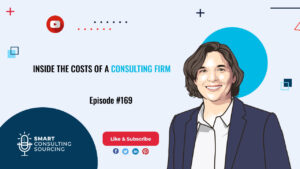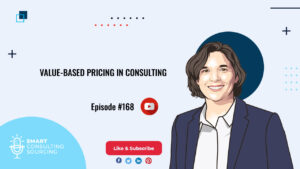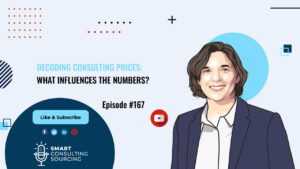Welcome back to Smart Consulting Sourcing, your trusted guide through the labyrinth of consultant procurement. I’m your host, Helene, and today we’re tackling a topic that can feel like a black box: saving money on consulting services!
But before we unlock the secrets of consultant savings, let’s rewind to last week’s episode where we peeled back the layers of consulting firm costs.
In the previous weeks’ episode, we dove into the nuts and bolts of consulting prices. We looked at how consultants figure out what to charge, what factors push those numbers up or down, and walked through the different types of fee structures, breaking down what they mean for you, the clients. We didn’t shy away from the hot topic of value-based pricing either, shedding some light on this trend that’s gaining traction but still leaves a few folks scratching their heads.
Consider it your crash course in Consulting Economics 101. So, if you’re starting here, might I suggest a little homework? Take a leap back and check out our previous episodes. They’re parked on every podcast platform known to humankind and YouTube for the visual souls. And for those who love a good read, yes, we’ve got transcripts! Find them lounging on our website, consultingquest.com, under the ‘Thought Leadership’ section, soaking up some digital sun.
Now, understanding the dollar signs attached to consulting is crucial, but let’s not get too starry-eyed over price tags. Price, my friends, isn’t the be-all and end-all of negotiations. Oh no, we’re about to embark on a new journey – ‘Decoding Cost Savings in Consulting’. This series promises to unravel the mysteries of savings in the consulting world, touching on everything from the impact of savings and demand management to the art of scoping and the dance of price negotiation.
Today marks the grand opening of this series, where we’ll peel back the layers of what savings really mean in consulting—and spoiler alert, it’s not just about counting pennies. So, buckle up as we dive into the first episode, setting the stage for a series that’s sure to add a few arrows to your quiver when it comes to navigating the consulting jungle. Let’s get started.
Alright, let’s kick things off by delving into something that sounds a bit like corporate speak but stick with me because it’s cooler than it sounds: the Evolution of Performance Management in Procurement. Once upon a time, procurement was all about the basics – speed, spend under management, and how much you saved at the end of the day. Fast forward to now, and we’re looking at a whole new ball game.
It’s no longer just about how fast you can go or how much money you’ve managed to stash under the mattress. We’ve moved into a world where procurement’s impact is measured in full technicolor – it’s about painting a complete picture that captures not just the savings but the value creation, cost avoidance, and even how happy your vendors are.
Why the shift, you ask? Well, it’s about being efficient versus being effective. Efficiency is doing things right – think hitting the right buttons on the calculator. But effectiveness? That’s doing the right things – choosing which numbers to crunch in the first place. In consulting procurement, this means not just getting services at the best price but ensuring those services transform into real, tangible value for the organization.
Savings. Now, there’s a word that gets tossed around like a hot potato. But when it comes to consulting, what are we really talking about?
Defining Savings in Consulting Procurement
In the consulting sphere, savings stretch beyond just dollars and cents. We’re looking at a holistic view that takes into account cost avoidance, how it affects your working capital, the performance of your vendors, and, most importantly, the creation of value. Traditional metrics? Sure, they give us a baseline, but the real magic happens when we start measuring effectiveness. It’s the difference between doing things right and doing the right things – like focusing on how procurement can actually enhance customer satisfaction, reduce errors, and leverage opportunities.
Dive a bit deeper, and you’ll find that modern procurement doesn’t just stick to one playbook. It’s got a two-pronged approach: Cost Reduction and Value Creation.
Cost Reduction is your classic procurement goal, where the focus is on tangible savings. It’s about balancing the scales between what you save and the resources you expend to achieve those savings. Think of it as the procurement version of ‘net benefits.’
Value Creation, on the other hand, is where procurement starts to wear a cape and transform into a superhero. It’s not just about cutting costs; it’s about opening doors to new opportunities and models of business that were previously uncharted. This is where concepts like open innovation come into play, turning procurement into a powerhouse of transformative change.
When we apply these principles to consulting procurement, things get interesting. Consulting isn’t just another commodity; it’s a blend of expertise, insight, and strategy. So, procurement in this context is less about snagging a bargain and more about ensuring that the service you’re bringing on board translates into genuine, measurable value for your organization.
Types of Savings in Consulting Procurement
You see, savings isn’t a one-size-fits-all concept; it’s more like a wardrobe with options for different occasions. Let’s walk through these options and sprinkle in some practical examples to bring these concepts to life.
Direct Savings
Think of direct savings as the discounts you snag during a sale. It’s the money you save upfront through better-negotiated rates, bulk engagements, or by playing the field with competitive bids. Imagine you’ve negotiated a 10% discount on a year-long consulting engagement because you committed early or bundled services. That’s direct savings – tangible, measurable, and sweet.
Cost Avoidance
Now cost avoidance can be a bit of a head-scratcher. Imagine you’re opting for energy-efficient windows for your house. It’s not just about the immediate aesthetics; it’s about the long-term savings on those heating bills, keeping you cozy for less cash as the seasons roll by.
Now, apply that thinking to consulting. Cost avoidance could look like tightening the scope of your project, honing in on what’s truly essential. It’s about saying, ‘Do we really need this part of the project, or can it wait?’ This approach helps you direct your budget towards activities that pack the most punch in terms of value, sidestepping those tempting ‘nice-to-haves’ that don’t quite justify their expense.
Operational Efficiency Savings
This is all about fine-tuning the engine of your operations to run more smoothly, efficiently, and yes, cost-effectively. It’s what happens when you adopt best practices that streamline processes, trim down cycle times, and naturally lead to savings.
Take the consulting world, for example. Imagine you decide to spruce up the quality of your RFPs. This one move can cut down a whole lot of back-and-forth, both within your team and with your potential consultants. A well-crafted RFP sends a clear message about what you need and shows you’re all singing from the same hymn sheet internally. The result? Consultants get a crystal-clear understanding of your project from the get-go, minimizing the need for endless clarification emails and meetings.
What does this mean for you? Faster sourcing, less time spent on the whole sourcing merry-go-round, and yes, tangible savings. In short, operational efficiency savings are about doing things better, not just cutting corners.
Value-driven Savings
Lastly, we have value-driven savings, which are all about the long-term gains. These might not show up directly on your financial statements right away but manifest as real benefits over time.
Imagine you’ve got a project on the horizon, one that’s expected to rake in $12M in value spread across 12 months. Simple math, right? That’s $1M a month. But here’s where timing becomes crucial. If you hit the snooze button and delay the start, every month of delay is essentially $1M left on the table. And let’s not forget – the longer you wait, the more you risk reducing the total value you could capture, thanks to factors like competitive pressures and changing market dynamics.
Now, let’s say the project kicks off as planned, and you’re pocketing your $1M a month. All is well. But here’s where consultants can change the game. With their expertise, you don’t just stick to the plan; you accelerate it. Suddenly, you’re not just hitting that $12M mark; you’re surpassing it, reaching $14M, and not in 12 months, but 10.
So, what’s the real saving here? It’s not just about the additional $2M in value, though that’s certainly a win. It’s about the time saved – getting to your goal faster and more efficiently, often outpacing what you thought possible. This acceleration not only boosts your immediate financial health but can also position you more competitively in the market, capturing value before conditions shift or competitors catch up.
Understanding these different types of savings is crucial, not just for the sake of managing consulting projects better but also for negotiating with finesse. It’s about recognizing the immediate and eventual benefits of your consulting investments. As businesses and their needs evolve, so does the art of procurement, pushing us to be ever more agile, informed, and strategic in our approaches.
Unraveling Value in the Consulting Procurement Process
Let’s unravel the consulting procurement process, step by step, to see how each phase contributes to the overall value. Drawing on the wisdom of Mike Hawkins, who said, “You don’t get results by focusing on results. You get results by focusing on the actions that produce results,” let’s see how this applies across the board.
Scoping is about getting your project’s scope pinpoint accurate. It’s your North Star, guiding you through the budgeting wilderness. Get it wrong, and you could see your costs ballooning by 50 to 100%, not to mention the missed opportunities hiding in the shadows. It’s here that cost avoidance takes center stage, with value creation waiting in the wings.
Example: Picture a company eyeing potential acquisitions. Segmenting the task – from initial screening by consultants to internal management of identification, then engaging banks for negotiation, followed by different consultants for integration – ensures precision. Sloppy scoping? That’s a recipe for unnecessary spend and opportunities slipping through your fingers.
Sourcing is where you lay the foundation for value. Choosing the right consultants through competitive bidding can save you a hefty 30 to 50%. But pick wrong, and you might as well wave goodbye to those expected outcomes.
Example: A telecom giant sticking to its usual trio of consulting firms might seem competitive. But unless there’s a real chance for each to win projects periodically, it’s just a façade, potentially cranking up costs.
In Selecting & Negotiating, the focus is on ensuring you’re teaming up with the right partners under terms that favor your organization. This phase alone can influence your project’s cost-effectiveness by 5 to 15%, with an additional 5 to 10% savings through scope refinement and resource reallocation.
Example: If a company signals urgency without multiple consulting options on the table, they’re likely to face steeper quotes.
Without solid project management, your venture might as well be adrift. Poor management can flush up to 100% of your project costs down the drain.
Example: A key sponsor bows out mid-project in a global benchmarking endeavor without a strong governance structure in place, diluting the project’s focus and wasting resources.
The lack of solid performance metrics for consulting spells trouble. Not having a clear view of what you’re spending and what you’re getting can cost you 25% to 50% of your project’s potential value.
Example: A bank leans on a top-tier strategy firm for an organizational redesign, only to find the firm’s expertise doesn’t quite match the task at hand, exacerbated by a vacuum in performance measurement.
Focusing is all about smart allocation. Prioritizing projects with the highest impact over a scattergun approach amplifies value, making strategic sense over mere cost avoidance.
Example: A consumer goods company spreads its budget too thin, focusing too much on manufacturing and marketing, leaving procurement and supply chain in the lurch.
In this context, we highly recommend reading this insightful article: “Maximizing Value from Consulting: Where Should You Focus Your Efforts?” It answers the key question – where to concentrate your efforts to get the most value out of the consulting you obtain through the sourcing process.
The Value Creation Equation
Alright, let’s dive into something that’s a bit of a conundrum in the consulting world – the real value of consulting services. Now, ‘value’ is one of those words that gets tossed around a lot, but when it comes down to it, pinning a number on the value delivered by consulting can feel like trying to nail jelly to a wall. But fear not, because we’re going to break down what I like to call the ‘value creation equation’ to help us get a grip on measuring and maximizing the benefits consulting services bring to the table.
There’s a world of difference between just tallying up the immediate savings from a consulting project and truly grasping the broader spectrum of value it creates over time. Let’s walk through five primary ways we can look at this:
Option 1: Basic Savings Measurement – This is your ground level, where you look at the difference between what you initially thought you’d spend on a project and what you actually ended up paying. It’s like finding a $20 bill in your winter coat from last season – a nice immediate saving.
Option 2: Comparative Savings – Here, we dive a bit deeper. It’s not just about what you saved; it’s about understanding the savings in the context of what you could have spent had you chosen the most expensive option on the table. Imagine you’re comparing deals on a new laptop and realizing the one you got saved you a bundle compared to the top-priced option. That’s comparative savings – getting a clearer picture of the deal you snagged.
Option 3: Inclusive Savings – Now, we’re getting into the more nuanced territory of cost avoidance. This method makes you think about whether every part of the service you signed up for was necessary or if there were elements you could have skipped, saving dollars down the line. Picture deciding against a full home warranty when you know you’ll only need it for the major systems. It’s about avoiding unnecessary expenditures.
Option 4: Theoretical Value Calculation – This approach is all about the long game, considering the expected returns on the consulting service over time. It’s a forward-looking perspective, kind of like investing in a startup. You’re banking on the future returns the project is expected to bring.
Option 5: Comprehensive Value Analysis – The pièce de résistance of value measurement. This method pulls everything together – the impact, the expected returns, the actual costs, what costs you managed to dodge, and more. It gives you a 360-view of the value derived from the consulting work. Think of it as assessing a renovation project on your house, considering not just the expenses and immediate benefits but also how it improves your home’s value in the long run.
So, when you’re looking at a consulting project, remember it’s not just about the upfront cost or the savings you see on your invoice. It’s about understanding the full spectrum of value that consulting can bring to your organization, from immediate financial benefits to long-term strategic gains. By getting a handle on these different ways of measuring value, you’re better equipped to see the big picture and make informed decisions about your consulting investments
Conclusion: Saving Money on Consulting Services
As we wrap up today’s deep dive, it’s clear there are myriad ways to define and measure savings in the consulting world. But if there’s one destination we’re journeying towards, it’s understanding value. The north star here isn’t just about tallying up direct savings. It’s about looking at the net value each project brings to the table.
Consulting isn’t just a line item to be managed under procurement; it’s a strategic tool that, when used wisely, can reinvest savings into driving further innovation and growth for the company.
This, however, presents a bit of a conundrum for our friends in procurement – savings reinvested don’t always show up in their ledger, affecting their performance metrics and, potentially, their bonuses. That’s why adopting a 360 perspective on value can harmonize procurement’s objectives with the broader goals of the organization. Pretty neat, huh?
And hey, speaking of value and investments, make sure you join us next week. We’re going to unravel ‘5 Ways Consulting Cost Savings Can Impact Organizations’. We’ll explore the delicate dance between cost and value, advocating for a mindset shift that views consulting not just as an expense but as a strategic investment.
Now, we’d love to hear your thoughts on today’s topic or anything else you’re curious about in the consulting realm. Feel free to drop us feedback, share your insights, or even suggest new topics. Head over to consultingquest.com and consource.io for more deep dives, white papers, and e-books that can illuminate your consulting journey. And if you liked what you heard, share the love – tell your friends, your colleagues, or that cousin who’s always talking about starting a business. Don’t forget to subscribe for the latest updates and episodes.
Thank you for tuning in to today’s episode! Your thoughts and feedback mean the world to me, so don’t hesitate to reach out on LinkedIn or via email at hcl@consultingquest.com. I’m always up for a chat! And if there are any topics you’d love to hear about in future episodes, send them my way too. Can’t wait to hear from you!
Until next time, stay safe and keep up the smart consulting sourcing game. Au revoir for now, and happy sourcing!







